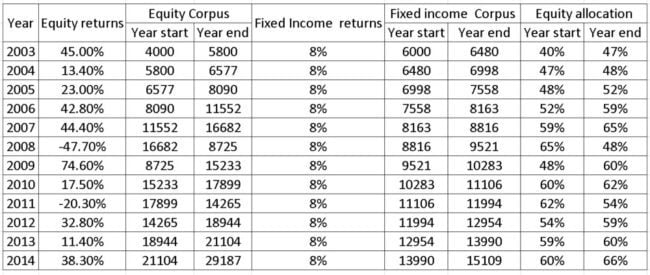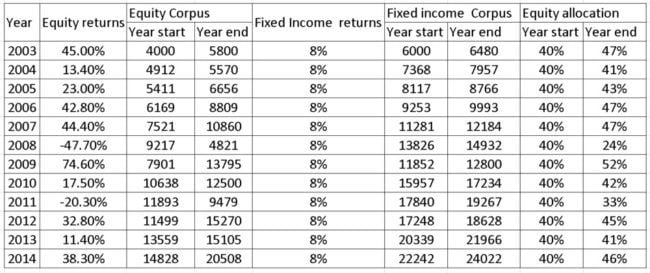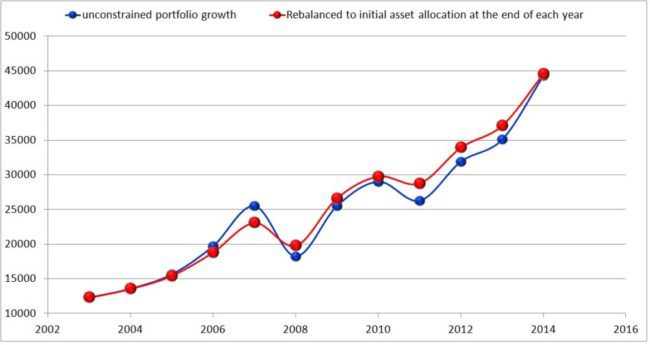Last Updated on April 23, 2023 at 1:02 pm
If diversification is about ‘not keeping all eggs in the same basket‘, rebalancing is realising that ‘what goes up, will come down‘. Yes, investment portfolio management is all about simple common sense. In this post, I would like to revisit the topic of portfolio rebalancing and discuss what it is, why do it is, and simple ways to do it.
I would like to thank Sunny Sachdeva for suggesting this topic, forcing me to reframe posts on rebalancing first published in May-June 2013 (links below). This is important for two reasons, (a) I have learnt a lot more in these three years and (b) I can probably write a lot better now than earlier.
What is portfolio rebalancing?
First, let us get a few things out of the way:
Join 32,000+ readers and get free money management solutions delivered to your inbox! Subscribe to get posts via email! (Link takes you to our email sign-up form)
🔥Want to create a complete financial plan? Learn goal-based investing? Exclusive access to our DIY tools? Increase your income with your skills? Enjoy massive discounts on our robo-advisory tool & courses! 🔥
Rebalancing is redeeming from one asset class and reinvesting immediately in another. Rebalancing is not profit booking.
Rebalancing is not timing the market.
Rebalancing is not a method to get higher returns.
Yesterday we looked at how to build a diversified portfolio. The primary idea behind this and behind any successful investment strategy is asset allocation (% exposure to equity, fixed income, gold etc.).
There are many types of asset allocation strategies (more on that later), but I would like to stick to a simple plan: 60% equity and 40% fixed income.
However, as we keep investing and as the value of these asset classes increases or decreases, the asset allocation will deviate from the target allocation.
Rebalancing refers to the method by which we reset the asset allocation. There are many ways to do this too. Will discuss a simple method here. Other examples can be seen in the posts below.
We start with a portfolio with X% equity allocation and Y% fixed income. At the end of each year, the asset allocation is reset back to X:Y (will become clear with the example below).
Let equity exposure be 40% (for illustration) and fixed income exposure 60%. Suppose a lump sum of Rs. 10,000 was invested at the start of 2003, the value of the equity portfolio and fixed income folio (fixed 8% return for simplicity) will evolve in the following way.

Notice how much the equity allocation varies from 40% at the end of each year. The idea behind rebalancing is to reset it back to 40% at the start of each year.

Note the lower volatility in the rebalanced portfolio. This is the primary objective of rebalancing. It is purely accidental that for the given set of returns, rebalancing has resulted in a higher value at the end of the tenure. For the above data set, this is true for any equity allocation from 36% to 99%.
I can easily show you another return data set for which rebalancing lowers volatility but also lowers final portfolio value.
When I say volatility, I am also referring to psychological comfort or mental peace, if you will. If the equity folio has moved up 90%, a fall is inevitable. Rebalancing is a way to cushion your mind and folio against such a fall. Whether it will lead to more returns or not is neither certain nor necessary.
Practical considerations
A diversified portfolio is ‘usually’ built with asset classes that are poorly or negatively correlated with each other. For example, a long-term gilt fund and equity is one way to do it.
Under ideal circumstances, interest rates are increased just before the start of a bull run. This allows the gains made in long-term gilts or gilt funds to shift to equity. As a bull run progress, inflation gradually increases and interest rates will also increase. Gilts would lose and the gains from equity can be shifted there.
Therefore, rebalancing is the process of shifting gains from an asset that has performed well to an asset that had done poorly but is expected to do well. This sounds easy to say, but quite hard to implement. Also, both asset classes can rally or crash at the same time.
I refer to this as two-way rebalancing, which is illustrated above, although the fixed income rate is 8%. Two-way rebalancing requires two poorly correlated volatile asset classes.
I generally prefer and recommend low volatile fixed income. For the simple reason, natural choices like PPF or EPF is available this way. If such fixed income is EPF of PPF, unconstrained withdrawals are not possible, and only one-way rebalancing is typically possible. That is, positive deviations from equity are shifted to fixed income. Negative deviations are ignored.
Positive deviations could have a threshold. That is, if equity allocation changes from 50% to 53%, do nothing. But if the difference increases by 5% or 10%, then and only then, rebalance.
I can use the benefit of hindsight to tell you what has worked. This does not mean such a strategy will work. If you like the idea of lower portfolio volatility and peace of mind by shifting gains to fixed income or vice versa, rebalancing will be a good idea.
How about taxes and exit loads? This can easily be lowered by letting a portfolio grow for a couple of years. Then withdrawals from equity funds will be free of tax and exit load (depending on fund structure).
Previous studies on rebalancing and portfolio management
Understanding Volatility of Investment Returns with a Portfolio Rebalancing Simulator
The What, Why, How and When of Portfolio Rebalancing With Calculators to Boot
Deciding on asset allocation for a financial goal
Asset allocation for long-term goals
Quantifying Portfolio Diversification – Part I
Portfolio Diversification with International Stocks
Portfolio Diversification: Correlation among Stock Sectors
🔥Enjoy massive discounts on our courses, robo-advisory tool and exclusive investor circle! 🔥& join our community of 7000+ users!
Use our Robo-advisory Tool for a start-to-finish financial plan! ⇐ More than 2,500 investors and advisors use this!
Track your mutual funds and stock investments with this Google Sheet!
We also publish monthly equity mutual funds, debt and hybrid mutual funds, index funds and ETF screeners and momentum, low-volatility stock screeners.





- Do you have a comment about the above article? Reach out to us on Twitter: @freefincal or @pattufreefincal
- Have a question? Subscribe to our newsletter using the form below.
- Hit 'reply' to any email from us! We do not offer personalized investment advice. We can write a detailed article without mentioning your name if you have a generic question.
Join 32,000+ readers and get free money management solutions delivered to your inbox! Subscribe to get posts via email! (Link takes you to our email sign-up form)
About The Author
 Dr M. Pattabiraman(PhD) is the founder, managing editor and primary author of freefincal. He is an associate professor at the Indian Institute of Technology, Madras. He has over ten years of experience publishing news analysis, research and financial product development. Connect with him via Twitter(X), Linkedin, or YouTube. Pattabiraman has co-authored three print books: (1) You can be rich too with goal-based investing (CNBC TV18) for DIY investors. (2) Gamechanger for young earners. (3) Chinchu Gets a Superpower! for kids. He has also written seven other free e-books on various money management topics. He is a patron and co-founder of “Fee-only India,” an organisation promoting unbiased, commission-free investment advice.
Dr M. Pattabiraman(PhD) is the founder, managing editor and primary author of freefincal. He is an associate professor at the Indian Institute of Technology, Madras. He has over ten years of experience publishing news analysis, research and financial product development. Connect with him via Twitter(X), Linkedin, or YouTube. Pattabiraman has co-authored three print books: (1) You can be rich too with goal-based investing (CNBC TV18) for DIY investors. (2) Gamechanger for young earners. (3) Chinchu Gets a Superpower! for kids. He has also written seven other free e-books on various money management topics. He is a patron and co-founder of “Fee-only India,” an organisation promoting unbiased, commission-free investment advice.Our flagship course! Learn to manage your portfolio like a pro to achieve your goals regardless of market conditions! ⇐ More than 3,000 investors and advisors are part of our exclusive community! Get clarity on how to plan for your goals and achieve the necessary corpus no matter the market condition is!! Watch the first lecture for free! One-time payment! No recurring fees! Life-long access to videos! Reduce fear, uncertainty and doubt while investing! Learn how to plan for your goals before and after retirement with confidence.
Our new course! Increase your income by getting people to pay for your skills! ⇐ More than 700 salaried employees, entrepreneurs and financial advisors are part of our exclusive community! Learn how to get people to pay for your skills! Whether you are a professional or small business owner who wants more clients via online visibility or a salaried person wanting a side income or passive income, we will show you how to achieve this by showcasing your skills and building a community that trusts and pays you! (watch 1st lecture for free). One-time payment! No recurring fees! Life-long access to videos!
Our new book for kids: “Chinchu Gets a Superpower!” is now available!


Must-read book even for adults! This is something that every parent should teach their kids right from their young age. The importance of money management and decision making based on their wants and needs. Very nicely written in simple terms. - Arun.Buy the book: Chinchu gets a superpower for your child!
How to profit from content writing: Our new ebook is for those interested in getting side income via content writing. It is available at a 50% discount for Rs. 500 only!
Do you want to check if the market is overvalued or undervalued? Use our market valuation tool (it will work with any index!), or get the Tactical Buy/Sell timing tool!
We publish monthly mutual fund screeners and momentum, low-volatility stock screeners.
About freefincal & its content policy. Freefincal is a News Media Organization dedicated to providing original analysis, reports, reviews and insights on mutual funds, stocks, investing, retirement and personal finance developments. We do so without conflict of interest and bias. Follow us on Google News. Freefincal serves more than three million readers a year (5 million page views) with articles based only on factual information and detailed analysis by its authors. All statements made will be verified with credible and knowledgeable sources before publication. Freefincal does not publish paid articles, promotions, PR, satire or opinions without data. All opinions will be inferences backed by verifiable, reproducible evidence/data. Contact information: To get in touch, use this contact form. (Sponsored posts or paid collaborations will not be entertained.)
Connect with us on social media
- Twitter @freefincal
- Subscribe to our YouTube Videos
- Posts feed via Feedburner.
Our publications
You Can Be Rich Too with Goal-Based Investing
 Published by CNBC TV18, this book is meant to help you ask the right questions and seek the correct answers, and since it comes with nine online calculators, you can also create custom solutions for your lifestyle! Get it now.
Published by CNBC TV18, this book is meant to help you ask the right questions and seek the correct answers, and since it comes with nine online calculators, you can also create custom solutions for your lifestyle! Get it now.Gamechanger: Forget Startups, Join Corporate & Still Live the Rich Life You Want
 This book is meant for young earners to get their basics right from day one! It will also help you travel to exotic places at a low cost! Get it or gift it to a young earner.
This book is meant for young earners to get their basics right from day one! It will also help you travel to exotic places at a low cost! Get it or gift it to a young earner.Your Ultimate Guide to Travel
 This is an in-depth dive into vacation planning, finding cheap flights, budget accommodation, what to do when travelling, and how travelling slowly is better financially and psychologically, with links to the web pages and hand-holding at every step. Get the pdf for Rs 300 (instant download)
This is an in-depth dive into vacation planning, finding cheap flights, budget accommodation, what to do when travelling, and how travelling slowly is better financially and psychologically, with links to the web pages and hand-holding at every step. Get the pdf for Rs 300 (instant download)